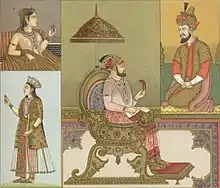Qaba (Persian: قبا qabā) is a long coat with sleeves and buttons, similar to a cassock, open at the front. A qaba is similar to a wadded coat. It is considered as a piece of clothing of Turkic origin.[2]
The Mughal emperors wore ankle-length garments. The outfits during the reign of Babur and Humayun are more or less the same, i.e. qaba, jama, pirahan, jilucha, jiba and kasaba. Unlike the jama, which was a four-pointed long-coat the Qaba and takauchia were of a broad girth at the bottom. There are mentions of the qaba in the Baburnama. At present, Qaba is one of the essential parts of the dress of the Islamic clerics or mosque leaders.[3][4][5][6][7][8][9][10] It was worn in Egypt, Turkey, the Levant, and Persia, among other places.[11]
In Arab contexts, two main variations were noted; the Turkish style (al-aqbiya al-turkiyya), and the Tatar (or Mongolian) style (al-aqbiya al-tatariyya or qabā' tatarī). The latter fastened on the wearer's right side, and was preferred by Mamluk amirs in its day over the former style, which was favored by the Seljuks and Ayyubids.[12] Also notable is a variation, typically with a v shaped neck, that closed center front.[13] The garment typically had a waistseam and some depictions indicate a gathered skirt. It was fastened with buttons or strings tied in bows, and most commonly worn with a belt over top.[12]
See also
Gallery
 Royal drinking scene in the Dukhang at Alchi Monastery, circa 1200 CE. The king wears a decorated Qabā'.[14]
Royal drinking scene in the Dukhang at Alchi Monastery, circa 1200 CE. The king wears a decorated Qabā'.[14] Babur and his heir Humayun
Babur and his heir Humayun Late 17th century portrait of Fírúz Jang Khán, ruler of Bijapur
Late 17th century portrait of Fírúz Jang Khán, ruler of Bijapur Late 19th century "Costume of India - Moguls" picture depicting Mogul woman (upper left), Mogul Emperor Farrukhsiyar (center) died 1719, and Emperor Humayun (upper right), died in 1556
Late 19th century "Costume of India - Moguls" picture depicting Mogul woman (upper left), Mogul Emperor Farrukhsiyar (center) died 1719, and Emperor Humayun (upper right), died in 1556 Vizier Qamar ud-Din circa 1735
Vizier Qamar ud-Din circa 1735 Portrait of "Mogul" father with his children in Delhi (Shepherd & Robertson) circa 1863
Portrait of "Mogul" father with his children in Delhi (Shepherd & Robertson) circa 1863
.jpg.webp) Page from the manuscript of Nihayat al-Sawl; Egypt, Mamluk era, 15th cent.; Museum of Islamic Art, Cairo.
Page from the manuscript of Nihayat al-Sawl; Egypt, Mamluk era, 15th cent.; Museum of Islamic Art, Cairo. Polo players painted onto glass with enamel and gold paint Egypt or Syria about 1300.
Polo players painted onto glass with enamel and gold paint Egypt or Syria about 1300. Enameled and Gilded Bottle.
Enameled and Gilded Bottle. Enameled and Gilded Bottle.
Enameled and Gilded Bottle.
References
- ↑ Flood, Finbarr Barry (2017). A Turk in the Dukhang? Comparative Perspectives on Elite Dress in Medieval Ladakh and the Caucasus. Austrian Academy of Science Press. p. 231.
- ↑ Flood, Finbarr Barry (2017). A Turk in the Dukhang? Comparative Perspectives on Elite Dress in Medieval Ladakh and the Caucasus. Austrian Academy of Science Press. p. 231.
- ↑ Balslev, Sivan (2019-03-21). Iranian Masculinities: Gender and Sexuality in Late Qajar and Early Pahlavi Iran. Cambridge University Press. p. 208. ISBN 978-1-108-47063-6.
- ↑ Johnson, Francis (1852). A Dictionary, Persian, Arabic, and English. Allen. p. 254.
- ↑ Islamic Thought and Scientific Creativity: A Quarterly Journal of the COMSTECH. COMSTECH. 1992. p. 66.
- ↑ Lal, Kishori Saran, 1920- (1988). The Mughal harem. New Delhi: Aditya Prakashan. ISBN 81-85179-03-4. OCLC 18431844.
{{cite book}}: CS1 maint: multiple names: authors list (link) CS1 maint: numeric names: authors list (link) - ↑ Agre, Jagat Vir Singh (1976). "Social Life as Reflected in the Rajput Painting During the Mughal Period". Proceedings of the Indian History Congress. 37: 569–575. ISSN 2249-1937. JSTOR 44139028.
- ↑ "India. The Mughal Empire. Costume and fashion history". World4. 2013-09-09. Retrieved 2021-01-29.
- ↑ Namrata Zakaria (2019-11-26). "Who made my clothes?". mumbaimirror.indiatimes.com. Retrieved 2021-01-29.
- ↑ "تاریخچه لباس روحانیت". خبرگزاری مهر | اخبار ایران و جهان | Mehr News Agency (in Persian). 2015-07-20. Retrieved 2021-01-29.
- ↑ Stillman, Yedida K. (2003). Stillman, Norman A. (ed.). Arab dress: a short history; from the dawn of Islam to modern times. Themes in Islamic studies (Revised 2nd ed.). Leiden: Brill. ISBN 978-90-04-11373-2.
- 1 2 Stillman, Yedida K. (2003). Stillman, Norman A. (ed.). Arab dress: a short history; from the dawn of Islam to modern times. Themes in Islamic studies (Revised 2nd ed.). Leiden: Brill. p. 63. ISBN 978-90-04-11373-2.
- ↑ Stillman, Yedida K. (2003). Stillman, Norman A. (ed.). Arab dress: a short history; from the dawn of Islam to modern times. Themes in Islamic studies (Revised 2nd ed.). Leiden: Brill. p. 353. ISBN 978-90-04-11373-2.
- ↑ Flood, Finbarr Barry (2017). A Turk in the Dukhang? Comparative Perspectives on Elite Dress in Medieval Ladakh and the Caucasus. Austrian Academy of Science Press. p. 243.
